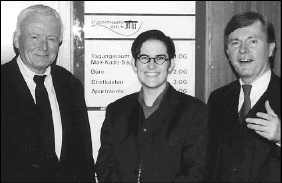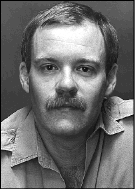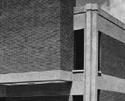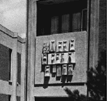
|

|
|
|
|
| | VOLUME 29, NUMBER 26 | WEDNESDAY, MARCH 31, 1999 | ISSN 1199-5246 | | |
|
|
||||||||||
|
|
By Sandra Guiry Crossing the Line: Violence and Sexual Assault in Canada's National Sport is the title of a book by Laura Robinson, and the subject of a talk held recently at York. Robinson, who is a former elite athlete in Canadian cycling and nordic skiing, opened her talk on abuse in Canadian sport by saying why she wrote the book(s). (Robinson is also the author of She Shoots, She Scores: Canadian Perspectives on Women and Sports.) Through her experiences in sport and her travels as a freelance journalist, Robinson recognized the unspoken abuse that exists in sport. There are many kinds of abuse that permeate sport in Canada and it exists at all levels from novice to elite, she told her audience. Athletes experience sexual harassment and assault from coaches, other sport officials, and other athletes whether it is verbal harassment, sexual touch or contact, or hazing or initiation practices. Especially coaches, Robinson says, operate in unspoken terms. "Athletes are made to feel obligated and it is rare that the abuser makes propositions explicitly." Robinson has interviewed many female athletes about experiences within sport, but other women, such as groupies, are at risk too. In her book, Robinson was discouraged from printing real names and places by her publisher for legal reasons, but tells the stories of girlfriends and groupies of hockey teams and players who have been physically abused, sexually assaulted and even gang raped. At this point, Robinson began her research. She starting by asking herself, is this abuse perpetrated by just a sick group of people or is it part of a culture? She found a distinct culture of abuse around hockey and other sports. That is not to say that all sports or all coaches and athletes are abusive, but a culture does exist. Some comments Robinson has received include, "...that *****! What could she have to say about something she knows nothing about?" Her work and interviews, however, have struck a cord with many athletes who have internalized and attempted to forget their abusive experiences. Much of the feedback Robinson receives is of former athletes thanking her for speaking out about the abuse, from which they have long suffered. One element of the culture which targets women, Robinson discovered, can be referenced back to a general derogation of women which is prevalent in hockey. On a hockey team, the rookie is commonly referred to as a "bitch" or the "designated female". "They make you into a weak women," says Robinson. On one occasion, members of a hockey team were derogated this way because they didn't win their game. The general tendency Robinson found was that when boys on a hockey team perform badly they are called terms that refer to females. "You are harassing a boy if you call him a girl," says Robinson. One effect of Sheldon Kennedy's public announcement of molestation and abuse as a young hockey player by his coach, has been the Canadian Hockey Association addressing pedophilia in hockey, establishing guidelines about what abuse is, and the repercussions of a finding of abuse. Robinson applauds better protections for children. However, as Robinson pointed out to the Association, these guidelines do not protect heterosexual adult relationships which may involve many women athletes. "The abuse of children is only one type of abuse listed in the guidelines," says Robinson. Unless another type of problem comes to light to the Board, they argue the guidelines are fine. In this way, Robinson states, "the needs of women remain invisible." After the talk, Robinson opened up the discussion to the audience for comments. Issues about the responsibility of parents of children involved in sport were addressed. One member of the audience suggested that children may feel like they are betraying the team if they tell their parents what is going on. Some parents live vicariously through their children and become part of the problem. Some discourage their children from leaving sport. According to Robinson, one father, threw a junior-level hockey player out of the house for quitting the team. In the end, "it's going to be people who care about children who make a difference," Robinson concluded. Sandra Guiry is a graduate student in political science at York University.
|
|||||||||
|
|
The Trans/formation of Canadian theatre from theatre in Canada was the focus of the 13th Annual Robarts lecture held recently at York. Presented by the 1998-1999 Chair of the Robarts Centre for Canadian Studies, Professor Robert Wallace, on March 15, 1999, the lecture was highly anticipated; the Senate Chamber was filled to capacity. The event began with a word from the Director of the Robarts Centre, Daniel Drache who thanked Wallace for all the work he has done to make the Theatrical Trans/formations series a great success. He also spoke about the background of the annual Robarts lecture, which is "always on the cutting-edge", Drache said. A formal introduction by Professor Robert Fothergill, chair of the Theatre Department, announced the appointment of Susan Swan as the Robarts Chair for 1999-2000. Fothergill also spoke highly of Wallace saying, "the theatrical trans/formations series has enriched the extracurricular year of this campus." Wallace's theme for the lecture considered the question "Has theatre in Canada become Canadian theatre? If so, how?" Throughout, Wallace argued the affirmative. With the ability of alternative theatre to differeniate itself from mainstream or regional theatre through the subsidies from the government(s), Canadian theatre has been able to grow. This, of course, would not have been possible without the growth and support of Canadian drama and plays. As a student of the University of British Columbia in 1967, Wallace noted the absence of plays written by Canadians in his English courses. When he approached a professor with this query, the professor responded that there simply wasn't any. Well, Wallace knew this to be untrue, and that rather Canadian drama had yet to "expand its horizon of expectation" by writers and readers, Wallace said. The intertwined relationship between Canadian drama and theatre is one in which the production of Canadian theatre is dependent on creation of Canadian drama. As of 1982, hundreds of Canadian plays were written and subsequently a dozen or so were produced in theatres. In the historical development of Canadian theatre the need for a "public" (audiences) is a recurring problem. In the mid 1980s service organizations were established to support the growth in Canadian theatre companies, productions, and venues such as the Playwrights Union of Canada. "Service organizations began to strategize the development of their public [audiences]," said Wallace. One strategy was to lobby governments for further funding for the arts, or more accurately, to stop the cutting of funding for the arts. In marches on parliament, artists and coalitions of artists argued public subsidy for the arts is a right. In the development of alternative theatre, structural changes were demanded by the National Arts Council in order to receive funding and encourage theatre companies to seek private funding. As a result, many alternative theatre companies by the 1980s had acquired real estate, established union fee scales, created Boards of Directors, and in general had developed an internal corporate model. The effect of these changes is that alternative theatre turned into something similar to the regional theatres, making commerical choices in production. From the 1980s onward the success of commercial enterprises such as "Cats" at the partially refurbished Elgin Theatre and "Phantom of the Opera" at the refurbished Pantages Theatre has grown. Many independent alternative theatre groups are now struggling even with some international and national success. But, as Wallace stated, "some alternative theatre members still have to work as part-time taxi drivers and waiters" to pay the bills. Wallace's lecture was the final of a series of free public events entitled Theatrical Trans/Formations, held over the past five months at York and organized by Wallace. The series presented many varied trans/formations of Canadian theatre including: Canadian theatre from "amateur pastime" to "cultural industry"; from "process" to "product"; from "nothing" to "something"; from "French-Canadian" to "Québécoise"; transforming genre "poetry in space"; Native theatre from "perseverence" to "power"; and transforming gender from "presumption" to "performative". The series brought to York some of the most influential and "cutting edge" theatre artists in Canada. Representing dance, theatre and performance art, such artists included: David Mirvish, Sherrie Johnson, Leslie Lester, Alejandro Ronceria, Daniel MacIvor, Daniel Brooks, Hillar Littoja, Paula de Vasconcelos, Pol Pelletier, Carol Greyeyes, Yvette Nolan, Audrey Butler, Diane Flacks, and David Bateman. Sandra Guiry is a graduate student in political science at York University.
|
|||||||||
|
|

Heather Cameron (centre) pictured here with Professor Emeritus Doctor Baring, head of the Parliament Scholarship Fund (left) and Mr. Adler, Member of the Berlin Parliament. Heather Cameron, a doctoral student in social and political thought, and member of York's Canadian Centre for German and European Studies' PhD diploma program, has recently been awarded a large scholarship by the Berlin Parliament. This prestigious award is presented annually to eighteen scholars from all over the world to pursue further study in Berlin. Cameron is only the second Canadian to win the award. Cameron went to Berlin in 1997 as the inaugural student on the York, Free University exchange program. She liked Berlin enough to stay there to finish her dissertation on French philosopher Michel Foucault's concept of care of the self and the Weimar Republic. While in Berlin, Cameron is sending radio essays back to be broadcast on CBC radio The Arts Today. "Berlin is a tremendously exciting place to be right now," says Cameron. "I hope more students become involved with the new Centre [for German and European Studies] and travel here. Germans and Canadians have a lot we can share with each other."
|
|||||||||
|
|
CST Symposium on Active Learning: A Report by Alok Mukherjee "Active Learning" was the somewhat paradoxical-sounding title of a one-day symposium held by the Centre for Support of Teaching (CST) on Monday, Feb. 15, 1999. After all, shouldn't all learning be active? That is to say, shouldn't learners be active participants in the knowledge making, and not passive vessels in which knowledge is poured by the expert? That is so, in theory. To make it so in practice requires deliberate thought and strategy. We owe to practitioners of adult education and popular education many insights and ideas about participatory learning. They have suggested a number of principles for creating the optimum learning conditions for adults. For example, people learn best when:
These principles can be profitably adapted to teaching and learning at the university to ensure the active involvement of the learner. Given that university students are adults, the university should by definition be a site for active learning. That, ironically, is not always what happens. The very set-up of the physical space - lecture theatres or classrooms, for example, with either fixed seats or chairs arranged in rows facing the instructor - reflects the idea of a place where the professor transmits knowledge and the student receives it. It was, therefore, encouraging to discover that so many educators at York are going against the grain, as it were. Presenters at the symposium, which was designed to model "active learning," demonstrated the ways by which they are turning their classrooms into places of interactive and participatory transactions involving the students and the instructor equally in the production of knowledge. Three of the eight sessions dealt with interactive possibilities of online learning. The electronic classroom and online instruction are not generally considered to permit interactivity and collaboration. These sessions challenged that popular perception. Models of online learning are being developed/used at York, at both undergraduate and graduate levels and in very different settings, which allow students to engage in an organic process, rather than as end-users only, and to participate in collaborative activities. In one case, students and faculty from five universities were engaged in such a process. The other five sessions focused on ways of turning the "traditional" classroom into an "active" classroom. They offered quite a wide range of very interesting strategies that the presenters have used in teaching courses at undergraduate and graduate levels. One graduate course, for example, which emphasizes close textual reading, places much of the interpretive responsibility on the students through a variety of written work that they share with the class. Another course, aiming to achieve active learning at the individual level, uses meditation and "raw writing" techniques to enable students to seek writing material within themselves. A library program, on the other hand, turns library research itself into an opportunity for critical learning by showing undergraduate students the dangers of accepting reference materials, such as Web, newspaper and magazine articles, without questioning. The program trains students to review materials critically for biases, distortions and inaccuracies, and thus become active learners. The usefulness of small group activities for enhancing student learning was emphasized in two of the sessions, as well as in the opening plenary. These plenary and session presenters demonstrated several techniques and games which can be used to facilitate effective group processes. As this brief summary suggests, there are any number of ways to ensure that the student is engaged in active learning. These may range from methods that are geared towards enhancing the learning environment for each individual student to those that seek to encourage collaboration, team work, exchange of experiences, etc. in the class as a collective. Particularly useful were three considerations that two presenters keep in mind in conducting their graduate seminar in Education. These were Liberating Constraints, Gathering Locations and Inventing Subjects. If an important goal of active learning is to ensure that learners become "inventing subjects," then it is very important for the instructor to provide clear rules and expectations, "constraints," that is, which actually can be "liberating" because they set out the boundaries clearly, and to identify the "locations" in the form of issues, concepts and topics around which people can engage themselves and each other. These three considerations recognize that active learning does not mean a laissez faire classroom. In fact, the role of the instructor is critical in creating the conditions which would transform the learner into an "inventing subject." At the end of the day, participants were asked to identify the key learnings from the symposium. Group work was clearly considered critical for active learning. It was proposed that "Group learning is higher quality learning, in traditional and electronic." At the same time, participants acknowledged that group learning does not just happen, it has to be planned for. While emphasizing the importance of "having students make connections themselves," one group of participants suggested that, for students to do so, it was important for the instructor to:
Another key learning was related to the importance of enabling students to bring personal experiences into the learning process. It was suggested that a technique such as "PMI" could be used profitably to draw out personal experiences. Students could be asked to reflect on the Plus, Minus and Interesting aspects of a proposition. Such an exercise would allow them to react to the issue from their personal space and location. The final key learning was that doing rather than telling was the basis of active learning. That is to say, it was important for the instructor to "model" active learning rather than to just talk about it, and to use techniques like group work and games to facilitate it. Overall, participants agreed on the benefits of creating the conditions for active learning. They recommended that, by way of follow-up, consideration should be given to discussion of concrete strategies for overriding student and faculty resistance, relieving pressures to always interact, and turning large lectures and classrooms into active learning environments. "Where do we go from here?" This was the question on which the symposium ended. The day had been rich in ideas and insights. Participants wanted to make sure that they and others will have the opportunity to put these into practice. A widespread concern expressed towards the end related to institutional factors that can be barriers to this. Administrators and decision-makers clearly have an important role in dealing with these factors, and making the university truly a place for active learning. This brings me back to my beginning concern, namely, the physical set-up of space in the university as a potential barrier to active learning. Flexible room configuration is obviously critical for people to be able to engage in group learning. Yet, how many classrooms permit such flexibility? And how many of us have been advised against altering the arrangement of furniture because it may be disruptive? These are, it seems to me, the kinds of institutional questions that need to be considered as we reflect on the ways of promoting active learning. Alok Mukherjee is a doctoral student in English. He is known for his use of adult and popular education principles in designing and facilitating training programs in a wide variety of organizations.
|
|||||||||
|
|
||||||||||
|
|
Founders College Residence and Courtyard, 1960s
Founders College Residence and Courtyard, 1960s
|
|||||||||
|
|
DESPERATELY SEEKING FACULTY. As baby boom professors approach retirement age, Canada's three largest universities are bracing for competition to attract hundreds of high-quality faculty. The University of Toronto, Canada's largest research university, announced plans to hire 500 new faculty members by 2004. The University of British Columbia will need more than 800 professors by 2005, and York University seeks 250 new faculty by 2004. The anticipated hiring is good news for Canadian graduate students. But the Ontario Confederation of University Faculty Associations (OCUFA) fears that small colleges and universities will be disadvantaged by the wealth and prestige of the larger universities. The University of Toronto plans to offer incentives, such as a spousal employment program and assistance with immigration procedures for non-Canadian faculty. (Source: The Toronto Star http://www.thestar.com 1/26/99 and 2/1/99.) BRITISH UNIVERSITIES TARGET MINORITIES. England's higher education budget provides 95-million pounds this year to help universities reach out to under-represented groups, such as the low-income families and ethnic minorities. The funding package also includes allocations to improve university buildings and equipment, and to create an additional 45,000 student places in higher education. (Source: BBC News http://news.bbc.co.uk 3/4/99.) GOING CONSERVATIVE. College campuses, once the breeding grounds for liberal student activism, are experiencing a conservative wave, reports USA Today. Conservative student groups are gaining in popularity and becoming more vocal on the issues that concern them, thanks to strong support from national conservative, libertarian, and Christian right organizations. Students in general are less liberal than they were two or three decades ago, UCLA professor Alexander Astin, an expert on student attitudes, told USA Today. He said liberal students currently outnumber conservative students by a dwindling margin. (Source: USA Today http://www.usatoday.com 2/23/99.) |
|||||||||
|
| Current Issue | Previous Month | Past Issues | Rate Card | Contact Information | Search |
|









